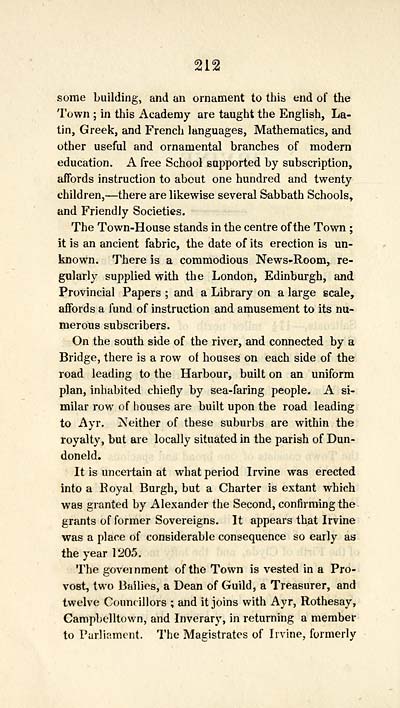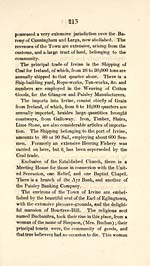Descriptive account of the principal towns in Scotland
(234) Page 212
Download files
Complete book:
Individual page:
Thumbnail gallery: Grid view | List view

212
some building, and an ornament to this end of the
Town ; in this Academy are taught the English, La-
tin, Greek, and French languages, Mathematics, and
other useful and ornamental branches of modern
education. A free School supported by subscription,
affords instruction to about one hundred and twenty
children, — there are likewise several Sabbath Schools,
and Friendly Societies.
The Town-House stands in the centre of the Town ;
it is an ancient fabric, the date of its erection is un-
known. There is a commodious News-Room, re-
gularly supplied with the London, Edinburgh, and
Provincial Papers ; and a Library on a large scale,
affords a fund of instruction and amusement to its nu-
merous subscribers.
On the south side of the river, and connected by a
Bridge, there is a row of houses on each side of the
road leading to the Harbour, built on an uniform
plan, inhabited chiefly by sea-faring people. A si-
milar row of houses are built upon the road leading
to Ayr. Neither of these suburbs are within the
royalty, but are locally situated in the parish of Dun-
doneld.
It is uncertain at what period Irvine was erected
into a Royal Burgh, but a Charter is extant which
was granted by Alexander the Second, confirming the
grants of former Sovereigns. It appears that Irvine
was a place of considerable consequence so early as
the year 1205.
The govei nment of the Town is vested in a Pro-
vost, two Bailies, a Dean of Guild, a Treasurer, and
twelve Councillors ; and it joins with Ayr, Rothesay,
Campbelltown, and Inverary, in returning a member
to Parliament. The Magistrates of Irvine, formerly
some building, and an ornament to this end of the
Town ; in this Academy are taught the English, La-
tin, Greek, and French languages, Mathematics, and
other useful and ornamental branches of modern
education. A free School supported by subscription,
affords instruction to about one hundred and twenty
children, — there are likewise several Sabbath Schools,
and Friendly Societies.
The Town-House stands in the centre of the Town ;
it is an ancient fabric, the date of its erection is un-
known. There is a commodious News-Room, re-
gularly supplied with the London, Edinburgh, and
Provincial Papers ; and a Library on a large scale,
affords a fund of instruction and amusement to its nu-
merous subscribers.
On the south side of the river, and connected by a
Bridge, there is a row of houses on each side of the
road leading to the Harbour, built on an uniform
plan, inhabited chiefly by sea-faring people. A si-
milar row of houses are built upon the road leading
to Ayr. Neither of these suburbs are within the
royalty, but are locally situated in the parish of Dun-
doneld.
It is uncertain at what period Irvine was erected
into a Royal Burgh, but a Charter is extant which
was granted by Alexander the Second, confirming the
grants of former Sovereigns. It appears that Irvine
was a place of considerable consequence so early as
the year 1205.
The govei nment of the Town is vested in a Pro-
vost, two Bailies, a Dean of Guild, a Treasurer, and
twelve Councillors ; and it joins with Ayr, Rothesay,
Campbelltown, and Inverary, in returning a member
to Parliament. The Magistrates of Irvine, formerly
Set display mode to: Large image | Transcription
Images and transcriptions on this page, including medium image downloads, may be used under the Creative Commons Attribution 4.0 International Licence unless otherwise stated. ![]()
| Gazetteers of Scotland, 1803-1901 > Descriptive account of the principal towns in Scotland > (234) Page 212 |
|---|
| Permanent URL | https://digital.nls.uk/97353513 |
|---|

